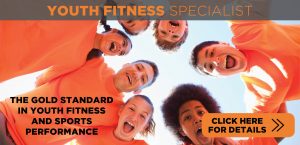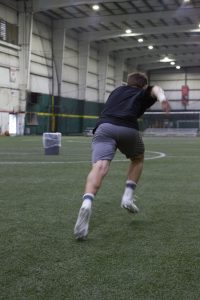Exercise Programming that Maximizes Brain Benefits
As young athletes develop, part of their growing skillset includes the ability to follow verbal instructions and make good decisions. This challenges kids to direct their attention and remain organized as they carry out goal-directed behaviors, using an ability known as executive function. Young athletes have an advantage in developing executive function because the brain regions that help us stay on task are highly sensitive to aerobic exercise. In fact, a child’s executive function is immediately improved by a single bout of physical activity.1-4 There is also a long-term cognitive improvement after regular exercise training,5-7 indicating that each season in which a child participates in regular practices may confer additive benefits to their executive function.
Why is executive function so important?
Part of every child’s potential for athletic success is based on their ability to focus, respond quickly, and adapt to new situations. While these skills certainly serve them on the field or court, it may come as no surprise that a child’s level of executive function predicts their success in school.8 Executive function develops slowly and matures during adolescence or early adulthood.9 This is why teams of older individuals can handle more complex tasks and follow directions more reliably.
Exercise primes the brain for improved executive function
The two major features that predict whether exercise will boost executive function are engagement and intensity.
Aerobic exercise that is highly engaging benefits executive function because more brain regions are activated, resulting in more blood flow to the brain. For instance, when teammates work together to complete a task, they show more activity in brain circuits important for listening and verbal communication. Practices that feature plenty of social interaction are a reliable way to keep athletes engaged and significantly improve their executive function.10 Beyond social interactions, higher brain activation also occurs when hand-eye coordination is challenged by complex tasks compared to simpler movements. Engaging forms of physical activity provide a longer lasting cognitive enhancement compared to repetitive and familiar types of exercise.11
Secondly, only moderate to vigorous exercise consistently improves brain blood flow and executive function.6 When this threshold of intensity is not reached, some studies failed to detect cognitive improvements, for example, treadmill walking in 7-11 year-olds,12 and stationary bicycling in 13-15 year-olds.13 For exercise to reliably improve brain function, it seems that the heart rate must be sufficiently increased. Intensity correlates to the athlete’s release of adrenaline (epinephrine), as well as the degree of neurochemical changes (in brain-derived neurotrophic factor) that optimize brain function.14,15 Selecting exercise intense enough for adrenaline release is also advantageous in terms of improving an athlete’s fitness and also closely matches the release of adrenaline that comes with competition during the athlete’s event or game.
Coaching for maximum benefits
As coaches, we are hopefully already structuring practices to include plenty of opportunities to cooperate and to adapt to new situations. These findings on brain benefits may convince you to introduce more variety to your warm-ups and conditioning exercises to ensure that your young athletes are reaping the full cognitive advantages. Some additional ideas to consider are shown in the video kindly provided by Jordi Taylor and Rona Guggemos:i
Exercises featured in the video:
- Dowel Run
- ISO Squat Ball to Cone
- Tennis Ball Throw Single Ball
- Tennis Ball Throw Double Ball
- Box Jump Hands on Head
- Box Jump Hands on Hips
- Sprint to Decel
- Plyo Box Sprint

Dr. Karlie Intlekofer earned her Ph.D. in Neuroscience and Behavior. She is a published author, researcher, and popular speaker. Karlie is also an expert on how exercise influences the brain and pediatric neuroscience. She currently works as a Global Wellness Researcher at Johnson Fitness & Wellness.
If you want to be better at coaching young athletes, the IYCA Youth Fitness Specialist certification is the industry gold-standard for youth fitness and sports performance. Click on the image below to learn more about the YFS1 certification program.
References:
- Budde H, Voelcker-Rehage C, Pietrabyk-Kendziorra S, Ribeiro P & Tidow G. Acute coordinative exercise improves attentional performance in adolescents. Neuroscience Letters (2008) 441: 219-223. https://doi.org/10.1016/j.neulet.2008.06.024
- Ellemberg D, St. Louis-Deschenes M. The effect of acute physical activity on cognitive function during development. Psychology of Sport and Exercise. 2010; 11: 122-126. https://doi.org/10.1016/j.psychsport.2009.09.006
- Hillman CH, Pontifex MB, Raine LB, Castelli DM, Hall EE & Kramer AF. The effect of acute treadmill walking on cognitive control and academic achievement in preadolescent children. Neuroscience. 2009; 3: 1004-1054. https://doi.org/10.1016/j.neuroscience.2009.01.057
- Pesce C, Crova C, Cereatti L, Casella R & Bellucci M. Physical activity and mental performance in preadolescents: Effects of acute exercise on free-recall memory. Mental Health and Physical Activity. 2009; 2: 16-22. https://doi.org/10.1016/j.mhpa.2009.02.001
- Davis CL, Tomporowski PD, Boyle CA, Waller JL, Miller PH, Naglieri JA & Gregoski M. Effects of aerobic exercise on overweight children’s cognitive functioning: A randomized controlled trial. Research Quarterly for Exercise and Sport. 2007; 78(5): 510-519. https://doi.org/10.1070/02701367.2007.10599450
- Davis CL, Tomprowski PD, McDowel JE, Austin BP, Miller PH, Yanasak N, Allison JD & Naglieri JA. Exercise improves executive function and alters neural activation in overweight children: A randomized controlled trial. Health Psychology. 2011; 30(1): 91-98. https://doi.org/10.1037/a0021766
- Hinkle JS, Tuckman BW & Sampson JP. The psychology, physiology, and the creativity of middle school aerobic exercisers. Elementary School Guidance & Counseling. 1993; 28: 133-145. https://psycnet.apa.org/record/1994-31406-001
- Blair C & Diamond A. Biological processes in prevention and intervention: The promotion of self-regulation as a means of preventing school failure. Development and psychopathology. 2008; 106: 461-472. https://doi.org/10.1017/S0954579408000436
- Best JR, Miller PH & Jones LL. Executive function after age 5: Changes and correlates. Developmental Review. 2009; 29: 180-200. https://doi.org/10.1016/j.dr.2009.05.002
- Serrien DJ, Ivry RB & Swinnen SP. The missing link between action and cognition. Progress in Neurobiology. 2007; 82: 95-107. https://doi.org/10.1016/j.pneurobio.2007.02.003
- Carey JR, Bhatt E & Nagpal A. Neuroplasticity promoted by task complexity. Exercise and Sport Sciences Reviews. 2005; 33: 24-31. https://journals.lww.com/acsm-essr/Fulltext/2005/01000/Neuroplasticity_Promoted_by_Task_Complexity.5.aspx
- Tomporowski PD, Davis CL, Lambourne K, Gregoski M & Tkacz J. Task switching in overweight children: Effects of acute exercise and age. Journal of Sport & Exercise Psychology. 2008; 30: 497-511. https://www.ncbi.nlm.nih.gov/pmc/articles/PMC2705951/
- Stroth S, Kubesch S, Dieterle K, Ruchsow M, Heim R & Kiefer M. Physical fitness, but not acute exercise modulates event-related potential indices for executive control in healthy adolescents. Brain Research. 2009; 1269: 114-124. https://doi.org/10.1016/j.brainres.2009.02.073
- Winter B, Breitenstein C, Mooren FC, Volker K & Knecht S. High impact running improves learning. Neurobiology of Learning and Memory. 2007; 87: 597-609. https://doi.org/10.16/j.nlm.2006.11.003
- Ferris LT, Williams JS & Shen C. The effects of acute exercise on serum brain-derived neurotrophic factor levels and cognitive function. Medicine & Science in Sports & Exercise. 2007; 39: 728-734. https://doi.org/10.1249/mss.0b013e31802f04c7




 Once the acceleration position has been refined and the athlete understands the basic reasoning and concepts that necessitate it, we move to starts. The tricky thing about having the body in the required position is that the only way to get it there is by leaning into or against something such as a sled or thick resistance band or by starting from positions that put you into a forward lean. The most common way we do this is with a traditional 3-point “40 yard dash” start, a falling start, or a single leg falling start. The point of emphasis must always be to explode out and to stay low. In the 3-point stance start, the trailing leg does very little other than cycle through (and ideally does so quickly in order to be in optimal position to take the next step). However, the lead leg is the one that must explosively push the athlete out because it is ultimately a series of strong, powerful, efficient “pushes” that lead to impressive acceleration. In his latest book Coach Mike Boyle describes a start drill he coaches that uses a large crash mat for his athletes to literally jump out and land on to teach the aggressive drive required to fully grasp this concept1. The athlete simply gets into a starting position and explodes out of the position so aggressively that he or she will essentially dive onto the ground. This is where the mat comes in handy!
Once the acceleration position has been refined and the athlete understands the basic reasoning and concepts that necessitate it, we move to starts. The tricky thing about having the body in the required position is that the only way to get it there is by leaning into or against something such as a sled or thick resistance band or by starting from positions that put you into a forward lean. The most common way we do this is with a traditional 3-point “40 yard dash” start, a falling start, or a single leg falling start. The point of emphasis must always be to explode out and to stay low. In the 3-point stance start, the trailing leg does very little other than cycle through (and ideally does so quickly in order to be in optimal position to take the next step). However, the lead leg is the one that must explosively push the athlete out because it is ultimately a series of strong, powerful, efficient “pushes” that lead to impressive acceleration. In his latest book Coach Mike Boyle describes a start drill he coaches that uses a large crash mat for his athletes to literally jump out and land on to teach the aggressive drive required to fully grasp this concept1. The athlete simply gets into a starting position and explodes out of the position so aggressively that he or she will essentially dive onto the ground. This is where the mat comes in handy!

 Do you have athletes that dream of playing in college?
Do you have athletes that dream of playing in college? 

 Joshua Ortegon is co-founder and the Director of Sports Performance Enhancement at Athlete’s Arena in Irmo, SC. Joshua earned his Bachelor of Science degree in Exercise Science from Western Michigan University in 2000.
Joshua Ortegon is co-founder and the Director of Sports Performance Enhancement at Athlete’s Arena in Irmo, SC. Joshua earned his Bachelor of Science degree in Exercise Science from Western Michigan University in 2000. Dave has been in the industry for nearly 15 years and has worked with top professional athletes and teams throughout the National Football League, Major League Baseball and more. His vision is to inspire people to live healthy lives and provide them with tools to do so.
Dave has been in the industry for nearly 15 years and has worked with top professional athletes and teams throughout the National Football League, Major League Baseball and more. His vision is to inspire people to live healthy lives and provide them with tools to do so. I have written a hundred plus articles on the topics of injury prevention, rehab, and sports performance but have not fully addressed something more profound…that youth sports are great.
I have written a hundred plus articles on the topics of injury prevention, rehab, and sports performance but have not fully addressed something more profound…that youth sports are great. 
 To us, a community is defined as a welcoming, positive training environment that includes supportive coaches and teammates. The community pushes and encourages each other.
To us, a community is defined as a welcoming, positive training environment that includes supportive coaches and teammates. The community pushes and encourages each other.
